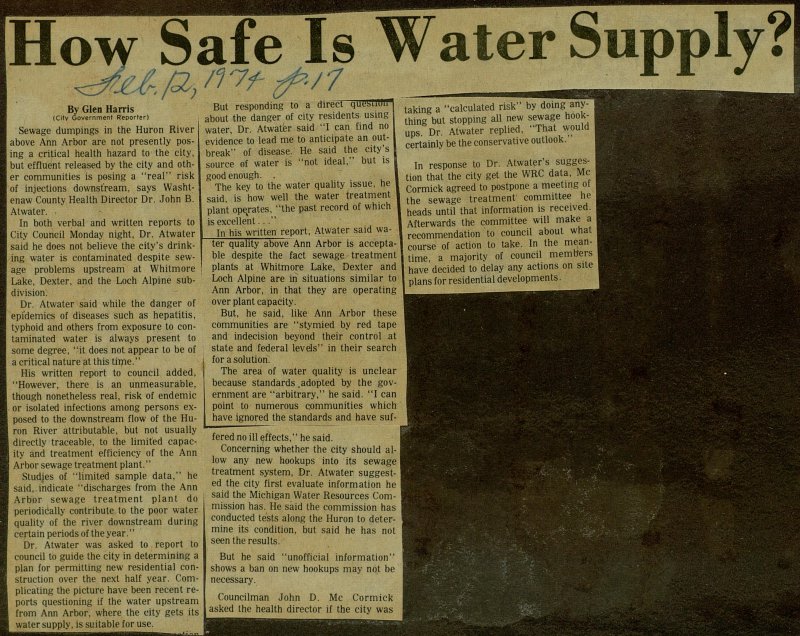How Safe Is Water Supply?

Sewage dumpings in the Huron River above Ann Arbor are not presently posing a critical health hazard to the city, but effluent released by the city and other communities is posing a "real" risk of injections downstream, says Washtenaw County Health Director Dr. John B. Atwater. In both verbal and written reports to City Council Monday night, Dr. Atwater said he does not believe the city's drinking water is contaminated despite sewage problems upstream at Whitmore Lake, Dexter, and the Loch Alpine subdivisión. Dr. Atwater said while the danger of epidemics of diseases such as hepatitis, typhoid and others from exposure to contaminated water is always present to some degree, "it does not appear to be of a critical nature at this time." His written report to council added, "However, there is an unmeasurable, though nonetheless real, risk of endemic or isolated infections among persons exI posed to the downstream flow of the Huron River attributable, but not usually directly traceable, to the limited capacity and treatment efficiency of the Ann Arbor sewage treatment plant." Studies of "limited sample data," he said, indicate "discharges from the Ann Arbor sewage treatment plant do periodically contribute to the poor water quality of the river downstream during certain periods of the year. " Dr. Atwater was asked to report to council to guide the city in determining a plan for permitting new residential construction over the next half year. Complicating the picture have been recent reports questioning if the water upstream from Ann Arbor, where the city gets its water supply , is suitable for use. But responding to a direci queUUUrn about the danger of city residents using water, Dr. Atwatér said "I can find no evidence to lead me to anticipate an outbreak" of disease. He said the city source of water is "not ideal," but is I goodenough. . I The key to the water quality issue, he I said, is how well the water treatment I plant opejates, "the past record of which I is excellent. ..." In his written report, Atwater said I ter quality above Ann Arbor is 1 ble despite the fact sewage treatment I plants at Whitmore Lake, Dexter and l Loch Alpine are in situations similar to I Ann Arbor, in that they are operating 1 over plant capacity. But, he said, like Ann Arbor these communities are "stymied by red tape ' and indecisión beyond their control at state and federal levéls" in their search 1 for a solution. The area of water quality is unclear because standards .adopted by the government are "arbitrary," he said. "I can point to numerous communities which have ignored the standards and have suffered no ill effects," he said. Concerning whether the city should 1 low any new hookups into its sewage I treatment system, Dr. Atwater 1 ed the city first evaluate information he I i said the Michigan Water Resources Commission has. He said the commission has I conducted tests along the Huron to 1 mine its condition, but said he has not I seen the results. But he said "unofficial information" shows a ban on new hookups may not be I necessary. Councilman John D. McCormick asked the health director if the city was taking a "calculated risk" by doing anything but stopping all new sewage hookups. Dr. Atwater replied, "That would certainly be the conservative outlook. In response to Dr. Atwater's suggestion that the city get the WRC data, McCormick agreed to postpone a meeting of the sewage treatment' committee he heads until that information is received. Afterwards the committee will make a recommendation to council about what course of action to take. In the meantime, a majority of council members have decided to delay any actions on site plans for residential developments.